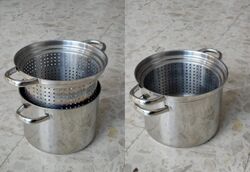Engineering:Colander

A colander (or cullender) is a kitchen utensil used to strain foods such as pasta or to rinse vegetables.[1] The perforated nature of the colander allows liquid to drain through while retaining the solids inside. It is sometimes also called a pasta strainer or kitchen sieve.
Description and history
Traditionally, colanders are made of a light metal, such as aluminium or thinly rolled stainless steel. Colanders are also made of plastic, silicone, ceramic, and enamelware.[2]
The word colander comes from the Latin colum, meaning sieve.[1]
Types
- Bowl- or cone-shaped – the traditional colander
- Mated colander pot[3]
Other uses
The colander in the form of a pasta strainer was adopted as the religious headgear of the religion Pastafarianism in deference to the Flying Spaghetti Monster.[4]
Colanders are also used during solar eclipses to project multiple images of a partial eclipse onto the ground for safe viewing of the eclipse.[5][6]
See also
- Chinois
- Filter
- Zaru
References
- ↑ 1.0 1.1 "colander". Merriam-Webster. 2011. http://www.merriam-webster.com/dictionary/colander.
- ↑ "Colander". 15 October 2010. http://www.cooksinfo.com/colander.
- ↑ "Mated Colander Pot". http://justcooking.in/dictionary/mated-colander-pot.
- ↑ "Pastafarian protester carries an icon of the Flying Spaghetti Monster at Piazza XXIV Maggio square in Milan, Italy, on June 2, 2012.". https://commons.wikimedia.org/wiki/File:9378_-_Pastafariano_al_Presidio_anticlericale,_Milano,_2_June_2012_-_Foto_di_Giovanni_Dall%27Orto.jpg.
- ↑ "Annular Solar Eclipse Safety". NASA. https://solarsystem.nasa.gov/eclipses/2023/oct-14-annular/safety/.
- ↑ "How to observe an eclipse safely". BBC. https://www.skyatnightmagazine.com/advice/how-to-view-the-eclipse.
External links
 |



